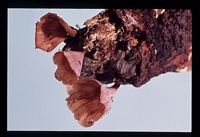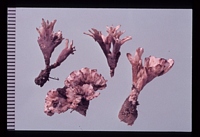|
 Podoscypha venustula subsp. cuneata Podoscypha venustula subsp. cuneata
SynonymsStereum affine
Stereum pusiolum
Cyphellostereum pusiolum
BiostatusPresent in region - Indigenous. Non endemic
Images (click to enlarge)
Caption: C-3617
Owner: Herb. PDD | 
Caption: C-3666
Owner: Herb. PDD |
Article: Cunningham, G.H. (1963). The Thelephoraceae of Australia and New Zealand. New Zealand Department of Scientific and Industrial Research, Bulletin 145: 359 p. Wellington:.
Description: Hymenophore pileate, annual, coriaceous, commonly
solitary, often gregarious, rarely caespitose. Pilei usually flabelliform or
spatulate, sometimes infundibuliform with one side split to the base, 2-4 cm
tall, 8-20 mm wide; pileus surface bay, bright chestnut or sometimes
ferruginous, even or radiately sulcate, concolorous or as often banded with
darker zones either radiately or transversely; sometimes silky and with
scattered surface hairs, more abundant in the darker zones and towards bases of
pilei; margin thinning out, crenate, sometimes deeply incised; hymenial surface
even, when fertile white and appearing farinose, creviced when old, radiately
sulcate. Stems arising from bay, prominent mycelial discs, to 8 x 1 mm, finely
velutinate, bay or umber. Context isabelline or wood colour, 0.2-0.6 mm thick,
composed of radiately arranged parallel hyphae; with a coloured cortex; skeletal
hyphae 4-4.5 µm diameter, lumena capillary; generative hyphae 3-3.5 µm diameter,
walls 0.2 µm thick, with clamp connections. Gloeocystidia arising from the base
of the subhymenium, traversing the hymenium but not projecting, some lying among
the context hyphae, cylindrical or ventricose-cylindrical, sometimes flexuous
and moniliform, 40-96 x 8-12 µm. Hymenial layer to 160 µm deep, a dense palisade
of basidia, paraphyses, gloeocystidia, and paraphysate hyphae. Basidia
subclavate, 16-25 x 5-6 µm, bearing 1-2-4 spores; sterigmata slender, erect, to
4 µm long. Paraphyses subcylindrical, 8-20 x 4-5 µm. Paraphysate hyphae scanty
or abundant, cylindrical, 3 µm diameter, projecting to 10 µm, sometimes
submoniliform. Spores oval or broadly elliptical, a few subglobose, 4-4.5 x
3-3.5 µm, walls smooth, hyaline, 0.2 µm thick.
Habitat: HABITAT:
Usually solitary on decorticated decayed wood lying upon the forest floor.
Distribution: DISTRIBUTION: East Indies, South
Africa, New Guinea, Australia, New Zealand.
Notes: Specific characters are the scattered and scanty often moniliform
abhymenial hairs, woody context, deep hymenial layer containing abundant long
and narrow gloeocystidia, small oval or broadly elliptical spores, spatulate or
flabelliform pilei attached to broad mycelial discs, and habitat. In several
features the species varies appreciably. Depth of the hymenial layer, and
consequent length of gloeocystidia, is affected by position, becoming deeper,
and gloeocystidia larger, from apices to bases of pilei. Abhymenial hairs may be
scanty or relatively plentiful, solitary or arranged in small tufts. Often
submoniliform, they are usually arranged in bands which traverse pilei
laterally. Pilei are usually flabelliform or spatulate; occasionally they may be
infundibuliform or campanulate, with one side split. Stems are attached to broad
mycelial discs; sometimes two or three arising from the same disc. Surfaces may
be concolorous or show lateral bands of darker brown. Spores are usually oval
or broadly elliptical, without apiculi, and measure 4-4.5 x 3-3.5 µm.
One of the collections was named by Cooke as S.obliquum Berk. &
Mont.; several others were misnamed by Lloyd as S. sowerbeii, S.
elegans, and S. surinamense.
Article: Cunningham, G.H. (1963). The Thelephoraceae of Australia and New Zealand. New Zealand Department of Scientific and Industrial Research, Bulletin 145: 359 p. Wellington:.
Description: Hymenophore stipitate, annual, coriaceous, seldom solitary, usually
gregarious. Pilei spatulate, cuneiform, narrowly flabelliform, sometimes
rosetted or as often torn into few or several lobes, 5-17 mm tall, 1-15 mm wide;
pileus surface radiately sulcate, sometimes toothed along ridges and margins, or
bearing subsidiary pilei, silky or glabrous, isabelline, straw colour with bay
margins, or concolorous; margins acute, dentate, or lacerate; hymenial surface
sulcate, even, where fertile drab-brown or pallid fuscous, with a broad sterile
bay margin. Stems arising from a mycelial bulb, 1-5 mm long, 0.5-1 mm thick,
naked, concolorous with the hymenium. Context 0.4-0.8 mm thick, wood colour or
light brown, composed of radiately arranged parallel hyphae; generative hyphae
2.5-3 µm diameter, walls 0.5 µm thick, naked, with clamp connections.
Gloeocystidia arising from the base of the subhymenium, scarcely projecting,
flexuous-cylindrical or cylindric-clavate, former to 80 x 8 µm, latter to 30 x
12 µm, when young filled with refractive, granular, pallid brown contents,
giving to the zone a discoloured appearance. Hymenial layer to 70 µm deep, a
dense palisade of basidia, paraphyses, and gloeocystidia. Basidia subclavate,
26-45 x 7-9 µm, bearing 2-4 spores; sterigmata slender, erect, to 8 µm long.
Paraphyses subclavate, 16-30 x 5-6 µm. Spores subglobose or pip-shaped,
apiculate, 4.5-6 x 4-4.5 µm, walls smooth, hyaline, 0.5 µm thick.
Habitat: HABITAT: Growing on soil, usually gregarious.
Distribution: DISTRIBUTION: West Indies, Central America, New Zealand.
Notes: Collections agree
in microfeatures with type specimens examined in Kew herbarium. These consist of
eight small plants, ex "Cuba, C. Wright, No. 510" and are smaller than typical
collections from New Zealand. Plants vary in size, shape, and colour. They are
constant as to habitat, contrasting colours of surface and hymenium, monomitic
hyphal system with clamp connections in generative hyphae, small subglobose
spores, and presence of gloeocystidia with coloured contents. Welden (1954, p.
431) thought the species so closely resembled S. radicans (Berk.) Burt
that it might be regarded as a variety. Judging from Lloyd's descriptions and
figures, it is probable that S. cuneoforme Lloyd, S. grandi
Lloyd, and S. multifidum Lloyd are synonyms.
|